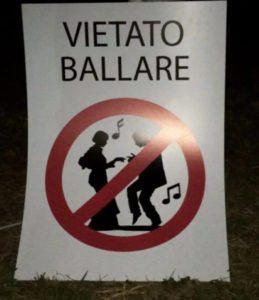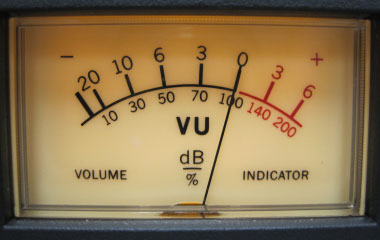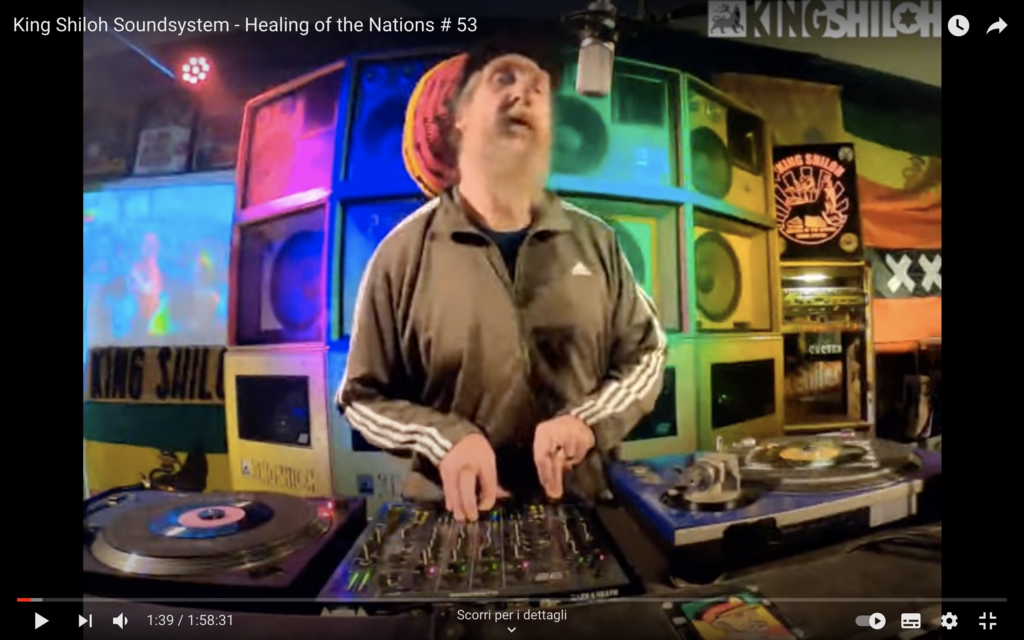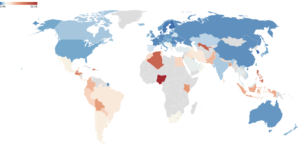Lost in Transition. When SST Go Digital
This piece investigates a few aspects of the pandemic-driven digitalisation of SST as a way to grasp ongoing and possible shifts in the affective and monetary economies of street sonic cultures. The scope is to get a deeper understanding of the unique features of SST, as well as to view from a different angle some of the ongoing systemic changes in the relation between technology and culture.
Social distancing, lockdown and curfews have put the whole music industry on an indefinite hiatus. Given the very same nature of the experience they offer, reggae sound systems and other sonic street technologies have been among the most severely affected by the health measures. The way they operate (often in public spaces, usually after dark, on the brink between legal and illegal regimes and economies) places them into a sort of ‘grey zone’ where state regulations cannot often be complied with. In most cases this has either prevented them from joining the list of activities that have experienced tentative (as well as severely policed) re-openings, or has attracted criticism in case of non-compliance (1).

Dance prohibition sign, Italy 2021. Covid-19-related dancing ban is still in place in the country.
In the meantime, practitioners and punters have found in social media and streaming platforms a way to cope with restrictions, keep in touch with sonic comrades, and find relief from the harshness of an uncertain present by virtually gathering in the covid-free space of the world wide web. But what exactly happens when a street-based sonic culture is abruptly forced to jump with both feet into the digital space?
Obviously, the digitalization of music is nothing new. Music has frequently migrated across different storage media during the last century – cassettes to CDs, minidiscs to pen drives – reaching its current zeitgeist in the ubiquitous archive of Spotify. In fact, what is arguably new here is not really the change in media as much as the change in mode – precisely, the mode of consumption. The digitalization of music fruition that the pandemic has accelerated has certainly helped to transcend continental boundaries and to suppress geographical distances. But this has gone in hand with the proliferation of a lone, home-based, small-speakers-powered listening experience.
The drive towards an intimate or domestic experience of recorded sound – backed by capital’s will to turn each music lover into a paying customer – has always been one of the driving forces in the development of sound technologies. Nonetheless this trajectory has always been balanced by an equally propulsive impetus towards enhancing an immersive experience of sound and the joy of collective listening. With all this being ruled, at least temporarily, as personally risky, socially reprehensible, and – often – entirely illegal, the ghost of a forced digital transition haunts the planetary dancefloor of SST. While waiting for the sound systems to take over the streets again, it seems worthy to consider this virtual interlude at least as a window to possible futures, and a chance to raise questions. What gets lost in the digital transition, and who’s left behind?
Intensity Shortage
What is immediately lost is the shared, multisensorial, physical experience of sound, which Julian Henriques aptly names sonic dominance:
“the visceral experience of audition, to be immersed in an auditory volume, swimming in a sea of sound, between cliffs of speakers towering almost to the sky, sound stacked up upon sound” (2).
While sonic dominance as auditory overload has precisely to do with intensities, it should not be dismissed as merely a matter of loudness. Or, put it another way: the power of sound to subvert the hierarchy of sensorial regimes lays beyond the measurability of actual sound power. A carefully induced state of altered consciousness which heads towards the embodied self as both individual and collective at once, sonic dominance is enabled by a sophisticated knowledge of sound, manifested through the accurate engineering of vibration which is part of the sound system operator’s embodied knowledge. It is the reckless result of an acrobatic play on the sound/noise threshold, where ‘pushing into red’ elicits pleasure rather than pain. And here comes the trouble.

Analog vu-meter heading towards red.
Since the early 1990s, fourth-generation music software have suddenly granted superhuman calculation ability to thousands of amateur music producers, leading to an era of hyperrhythm: “posthuman rhythm that’s impossible to play” (3). But while the digital environment opens for sound an infinite range of rhythmic possibilities, it puts the brakes on intensity as a crucial dimension of SST and on its modulation as a strategy for affective mobilisation. While tempo can be broken down into micro-rhythmic units that can be freely repurposed, intensity exceeds a computing capacity which is rather tuned on loudness. In other words, pushing digital sound waves into red doesn’t activate any pleasure, nor pain. The overload of sound is simply registered as an error, and conveyed as the vaguely annoying – but absolutely un-affective – digital clip. Robbed of its analogue machinery and embodied transducers, intensity gets lost in transition.
Lone Islands in the Net
Another burning issue is that of the accessibility and the reach out. According to the Alliance for the Affordability of Internet (A4AI) 2021 report, the cost of 1GB should be less than 2% of yearly income. Unfortunately, this is not the case in several countries. The cost of internet connection, exacerbated by the financial straits caused by the lockdown, together with the need to prioritize information and communication over entertainment, can easily turn a streaming session into a luxury for many.
The issues of the digital divide and the unequal access to the internet has resonated strongly throughout the online symposium SSO#7: Sound Systems at the Crossroads, and especially during the practitioner’s roundtable entitled The Sonic Challenge: Post-Pandemic Sound System Practices, held on 9 July 2021. As example, although showing “very proud” of their virtual community, all-female Brazilian crew Feminine Hi Fi has noted how the access to music streaming has been virtually neglected to the people living in Sao Paulo’s favelas, where some of their crowd dwell. While Doc Inity, who runs Kebra Ethiopia sound system, based in South Africa, has voiced the paradox of having his virtual sessions reaching more European followers than local residents – the same ones who normally ram his street dances in Kwa Thema.
These are just two examples, or islands, part of a wider digital archipelago of blind spots in the net. Based on the lack of financial means more than actual technological capacity, it threatens the allegedly unified (and unifying) narrative of the world wide web as an inclusive space of possibilities by replicating the same boundaries that affect the off-line existence of the unprivileged ones in the global society. And are precisely those who populate those high-pressured environments, which constitute the soil from which SST continue to bloom, who are left behind.
Free Entertainment or Free Labour?
But the most challenging issue surrounding SST in the online world is undoubtedly that of wealth production and distribution. During the lockdown music producers and artists have been kept afloat by dubplates recordings, record sales and streaming revenues. In this respect, a successful online performance can be immediately monetized. One notable example is the Bounty Killa x Beenie Man clash hosted by IG channel Verzuz TV in May 2020, which attracted an audience of 500k viewers, and even became a trending topic on Twitter. Both artists experienced the best Spotify streaming days of their careers immediately after, with a 187% boost for Beenie and an impressive 291% for Bounty.

Full Bounty Vs Beenie tracklist repacked by Spotify as a trending playlist.
Sadly, for SST there’s no product to be advertised by playing music online – playing music is precisely the product. The lockdown has thereby deprived practitioners of their primary source of income, leading to what veteran Jamaican soundman and Stone Love owner Winston ‘Wee Pow’ has described as “the most challenging of times”. For them, the fruits of a virtual session are, in the best case, to be reaped entirely in the post-pandemic world. Not really a suitable option to put food on the table. Nonetheless, many have taken up the cause with praiseworthy generosity.
Bredda Neil of King Shiloh sound system and crew have been streaming from their Amsterdam HQ on their FB page every single Saturday for 77 consecutive weeks so far. Aptly titled ‘Healing of the Nations’, these sessions have uplifted thousands of fans since then, and have collected more than 100k views on King Shiloh’s YouTube channel, where they have been archived since January 2021. While YouTube views can be monetized through ads, they produce a significant income only when hitting big numbers – notably millions, which is something that even the most established SST practitioners are far from achieving. But even more than numbers, it is the business model of digital platforms that should really be questioned.
During the late 1990s internet craze a few critical voices warned that the ultimate objective of all of the “free stuff” on the net was “to have you consume bandwidth” (4). Twenty odd years later, with the price of bandwidth continuously dropping, these claims may sound at least naif. In fact, they were onto something. The shift towards the web 2.0 has seen the rise of platform capitalism (5). The corporations competing in this arena don’t sell any product: their business model is almost entirely based on data harvesting. Hence the definition of free labour, with “free” standing for “simultaneously voluntarily given and unwaged”, once a prerogative of forum moderators, code developers and mailing lists participants (6), can now be extended to virtually include every single web user. The objective is to have you simply consume more time online, in order to extract more data. Or, put it differently: it is the very same online presence that generates wealth – a wealth which is mainly collected by the platforms themselves.

King Shiloh’s ‘Healing of the Nations’ n. 77, August 2021.
As a matter of fact, YouTube ads, Twitch subscriptions, Buy Me A Coffee or Facebook Stars provide ways to music and sound practitioners – generically labelled ‘content creators’ – to monetize their free labour. But they do so by putting the burden on the audience, both poisoning music with ads and inviting punters to support out of their pockets. It’s time to stand up for a fair share of the wealth that online presence generates, starting from the so-called ‘content creators’ – whose contribution to the well-being of a platform exceeds the value of single ads to include also the so-called “network effects” (7) – all the way down to the casual user. The ways, of course, are yet to be imagined. But who provides the flour should be entitled to a slice of the cake, isn’t it?
SST as media ecologies
It is also crucial to hold an understanding of SST as complex entities which cannot be reduced to the music they play, nor the person who’s in charge of it. They are rather socio-techno-cultural apparatuses, collectively-operated phonographic and sonic media themselves. As such, they remain part within a wider ecology made of other media, bodies, affects and cash flows, which they contribute to generate and fine-tune. This media ecology (8) is home (and provides income) to many, from the box-lifter to the peanut vendor. By absorbing the platform’s close-up as the default point of view, together with the focus on content creators, the risk is for the bigger picture to get lost, and for the most fragile figures in the scene to be left behind.
The most urgent need for SST is then to escape the capture by platform capitalism by parasiting the digital infrastructure in the same way they have successfully done with other existing technologies and environments. After all, sound systems have unexpectedly turned the domestic turntable into a performing instrument, added to the experience of listening to recorded music the pathos of a theatre play, and reconfigured dodgy street corners into coveted dancefloors. What they are able do in the digital age might be yet to be revealed.
—
Brian D’Aquino is Senior Research Assistant in the SST project. He’s an author, sound system practitioner and music producer based in the Southern side of Europe.
—
References:
(1) This is the case with the free tekno party hold Rennes, France, on New Year’s Eve 2021, or with the Space Travel Teknival held in Viterbo, Italy, in August 2021, among others.
(2) Henriques, Julian. 2011. Sonic Bodies: Reggae Sound Systems, Performance Techniques and Ways of Knowing. New York-London: Bloomsbury Publishing, p. xv.
(3) Eshun, Kodwo. 1998. More Brilliant than the Sun: Adventures in Sonic Fiction. London: Quartet, p. 068.
(4) Horvarth, John. 1998 “Freeware Capitalism”. Posted to nettime, 5 February, https://nettime.org/Lists-Archives/nettime-l-9802/msg00026.html
(5) Srniceck, Nick. 2017. Platform Capitalism. Cambridge-Malden: Polity Press
(6) Terranova, Tiziana. 2000. “Free Labour: Producing Culture for the Digital Economy.” Social text 18.2, p. 33-58
(7) Srniceck, Nick. 2017. Platform Capitalism. Cambridge-Malden: Polity Press, pp. 43-45.
(8) Fuller, Matt. 2005. Media Ecologies: Materialist Energies in Art and Technoculture. Cambridge MA: MIT Press.

